If you have read my Khanjar and Qaboos Rolexes: Are They The Vintage Watch Industry’s Blood Diamonds?, you may recall that in 1969 I was bought my first watch for my seventh birthday whilst on a family trip to Bahrain. I was certain that this watch had been lost to the sands of time, in one of many house moves between Oman and Scotland.
My last memory of it dated back to the mid-1970s and, as I recall, the movement had seized up. Purely from memory, I described the watch as “a manual-wind, steel-encased boys’ watch on a steel bracelet with a red second hand and luminous Mercedes hour and minute hands that lit up like Blackpool tower at night.”
So it’s little short of a miracle that on a recent visit to see my mother (shortly before the COVID-19 ban on visiting elderly relatives), while tidying away some boxes in her attic, I happened to peer into an open wooden box and there, lying on its side, now on an old black leather strap, was my first watch!
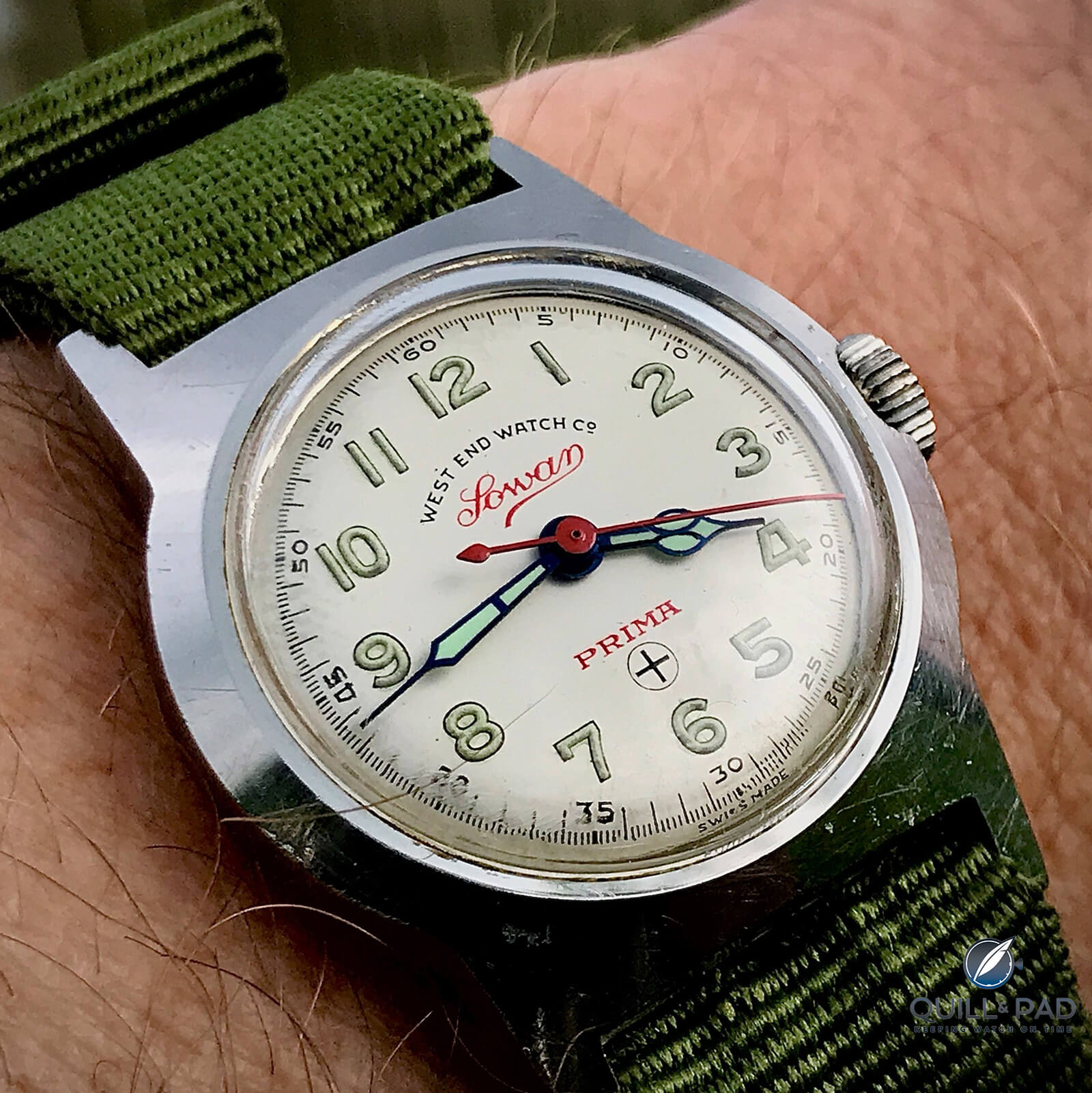
The author’s West End Watch Co Sowar Prima on the wrist (photo courtesy Colin Alexander Smith)
And even more astonishing, when I wound it up it started running perfectly! As you can see from the photo, the case and hands are exactly as I remembered them, and the lume is still remarkably strong given its age.
The second thing I did was to check the dial for the manufacturer’s name, something I did not recall. The dial reads WEST END WATCH CO – SOWAR below the 12 o’clock mark and PRIMA and SWISS MADE above and below the 6 o’clock mark.
This sent me scurrying online to find out more about this company. But the brand name was more than familiar, and it turns out that I had come across some West End Watch Co watches very recently and much closer to home. More on that later.

The lume on the author’s first watch is still going strong (photo courtesy Colin Alexander Smith)
Indian connection
According to the West End Watch Co website, not long after being founded in 1864 by Alcide Droz and Henri Perret as Droz and Perret, the company decided to target the Indian and Middle East markets, establishing itself under the brand name West End Watch Co as the leading brand in India, Nepal, and Tibet (making deliveries to the latter by yak when roads became impassable!).
In 1886 Droz developed l’Imperméable, the first waterproof pocket watch ever produced, which is now on display at the International Watchmaking Museum (MIH) in La Chaux-de-Fonds.
In another serendipitous connection with my Omani Rolex article, Chinese mountaineer Wang Fu-Zhou became the first man to conquer Mount Everest via the North Ridge in 1960 – wearing a West End Watch Co watch.
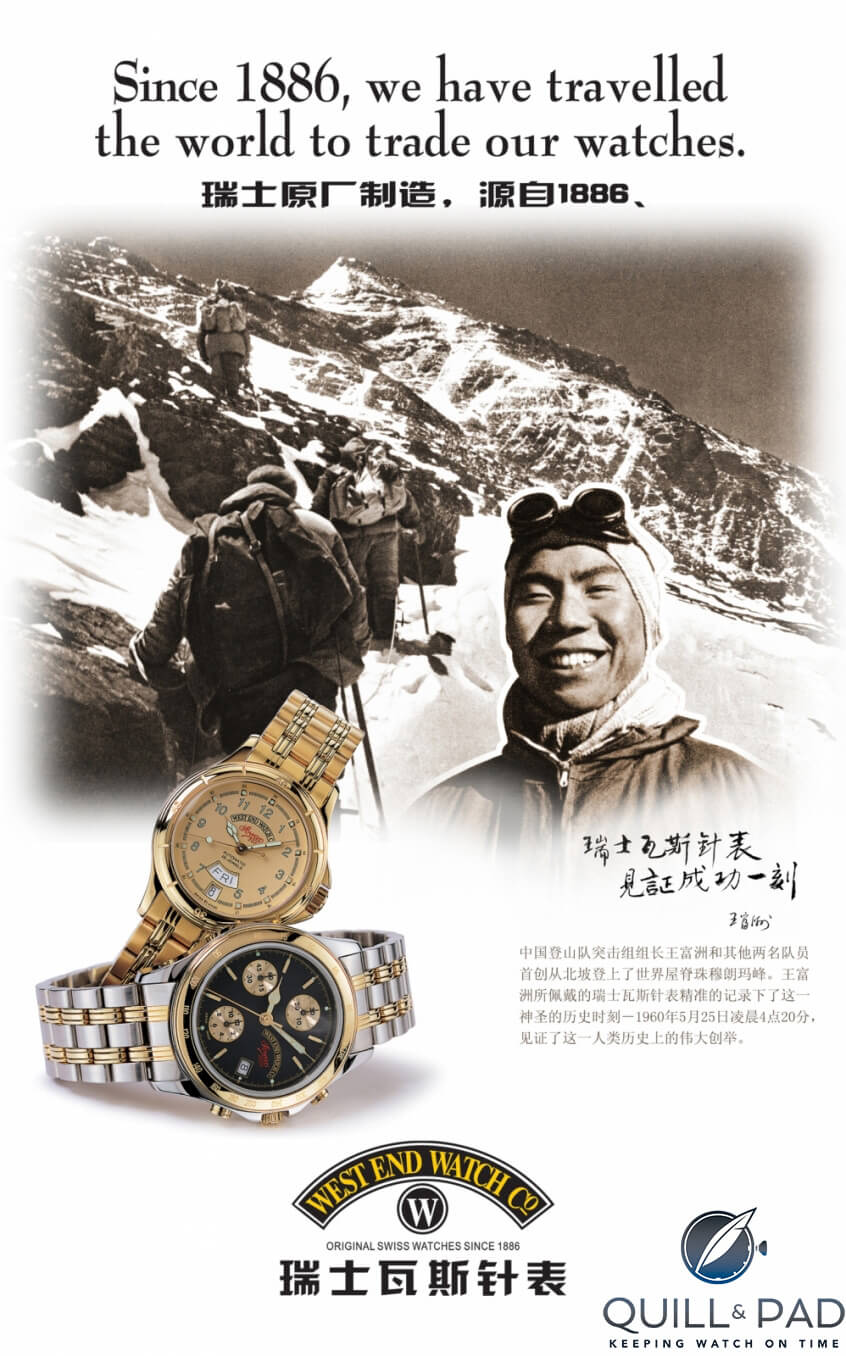
Chinese mountaineer Wang Fu-Zhou in a West End Watch Co ad
At various times West End Watch Co enjoyed manufacturing tie-ups with Longines and Mido, until 1955 being the only brand authorized to market Longines movements, including the 12.68z, under its own name.
Through its Bombay and Calcutta offices, where the West End Watch Co name was first adopted, by 1914 the company had supplied 50,000 watches to British Indian soldiers fighting in Iraq and was supplying watches to most of the Indian Railway companies.
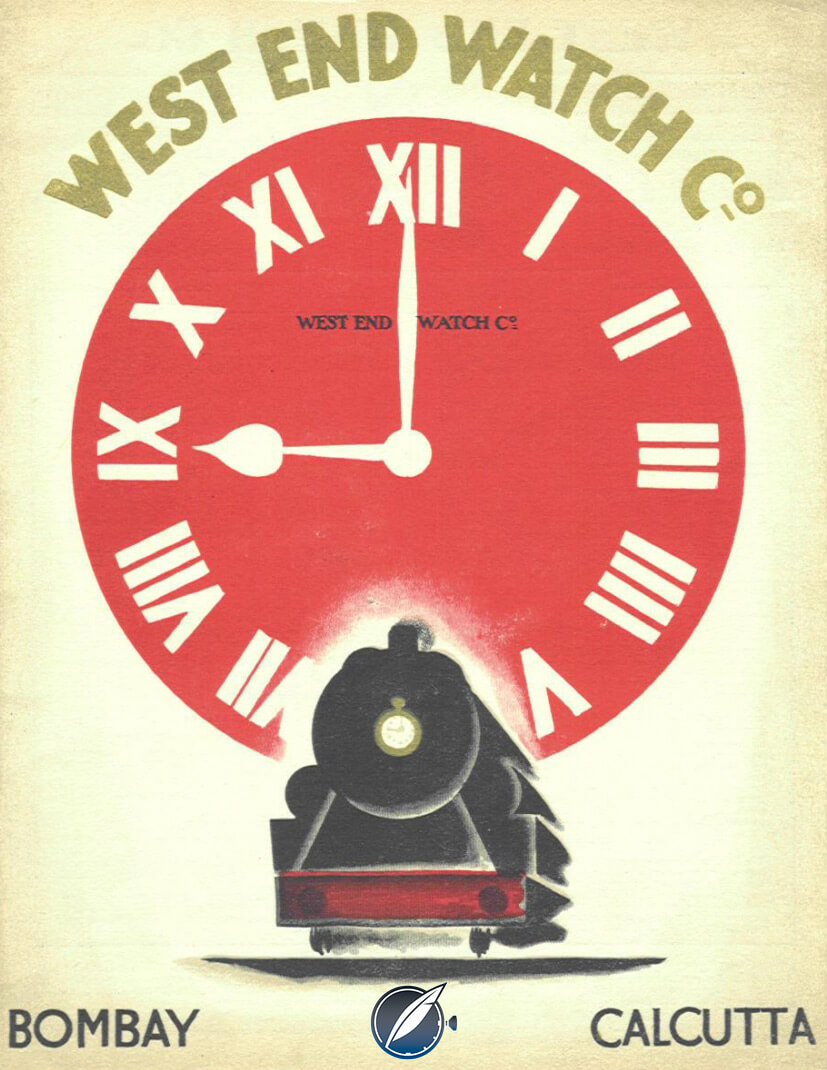
West End Watch Co Indian railways ad
In 1917 it launched the Sowar brand (Sowar means “one who rides” in Farsi and “cavalryman” in Hindi). My watch is a Sowar Prima, indicating that it was water resistant and shockproof, as the company had created its own waterproofing technology and was an early adopter of Incabloc shockproofing.
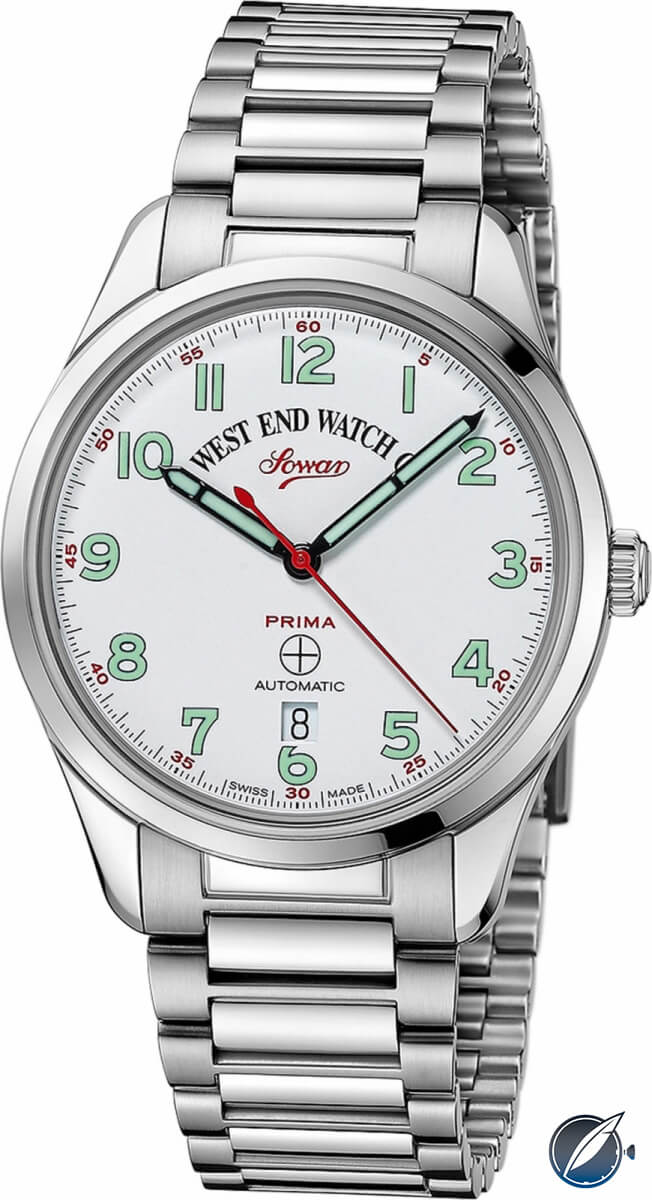
Current model West End Watch Co Sowar Prima
Given the strong trading links between India and the nascent Arab Gulf States it is therefore not surprising that if we were looking for a watch for me in Bahrain in the late 1960s, a West End Watch Co model would have been an obvious choice. As watch strap seller David Boettcher states in his comprehensive review, “The West End brand gave the Swiss-made watches a distinctly imperial feel, and the clever juxtaposition of Swiss precision engineering and an Empire brand name was a hit.”
Swiss movements
I am fairly certain that my Sowar has never been serviced and that the back has never been opened since it left the factory. This, combined with the waterproofing system, would explain why the dial and hands are in such good condition. The case back (on which I scratched my initials, undoubtedly with the compass from my standard issue “Oxford” mathematical instruments kit, evidence that I took it with me to boarding school) is a decagonal form similar to many dive watches of the period.

Back of the author’s West End Watch Co Sowar Prima with ‘engraved’ initials (photo courtesy Colin Alexander Smith)
In part due to its small size (25 mm) I have been quite unable to open it with the tools in my possession, so I am not able to identify or provide photographs of the movement, but I understand it would have been an ETA (or an associated company). However, I was able to find the following information on www.vintagewatchstraps.com:

Exploded view of a West End Watch Co Sowar Prima (photo courtesy www.vintagewatchstraps.com)
“The exploded view of a West End Sowar Prima shows how the watch was assembled using a Taubert Decagonal case. The movement, complete with dial and hands, is first dropped into the carrier ring and secured by the two case screws. The carrier ring is then inserted into the case from the back. The winding stem is then inserted through the stem tube, where the cork seal is already in place, and is secured into the movement by tightening the setting lever screw.
“The case back has 10 flats, hence the name Decagonal, which are gripped by the key used to tightening the back down onto a lead gasket. The lead gasket is not shown in the picture, it is already installed in the main part of the case at the bottom of the threads that the case back screws into.
“The West End Watch Co became thus one of the first companies to use the Incabloc shock resisting system in their watches, and they used Taubert’s waterproof Decagonal watch case with the cork stem sealing and screw back from 1934 until 1954, when Taubert were no longer able to keep up with West End’s demand, which by then had risen to more than 2,000 cases per month.”
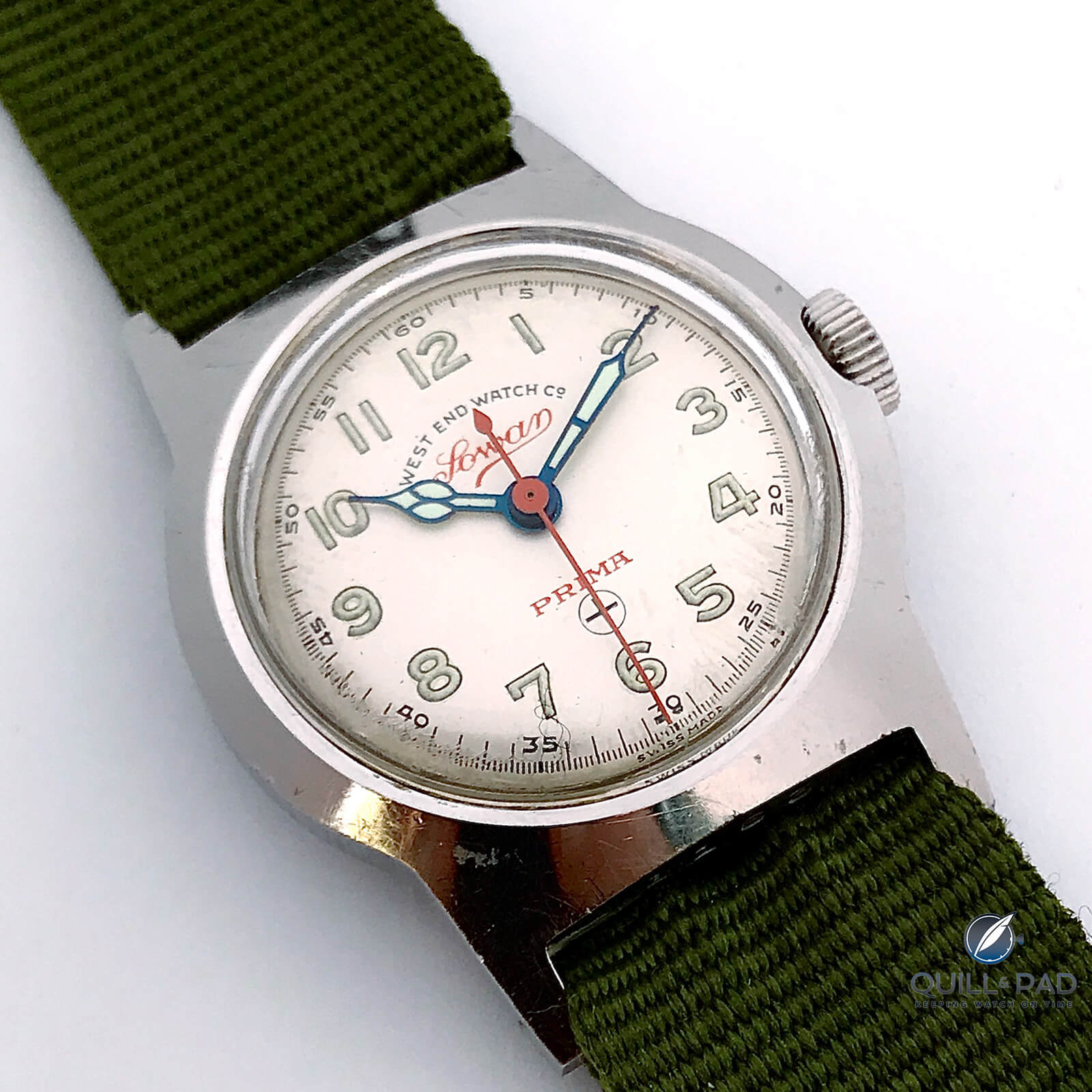
The author’s West End Watch Co Sowar Prima cleaned up pretty well (photo courtesy Colin Alexander Smith)
One striking aspect of a brand like this, given the pedigree of the company and the quality of its products, is the fact that 100 years ago there was little in technical, qualitative, and design terms to differentiate brands such as West End Watch Co from more well-known manufacturers like Ebel, Eterna, Minerva, and now-iconic brands like Rolex, Omega, and Longines – as evidenced by the broad selection of manufacturers included in the Dirty Dozen, even back in the 1940s.
This may sound fanciful, but the proof of this lies in the extent to which these companies supplied each other with movements and cases. West End Watch Co originally had its movements made at parent company Droz & Cie’s factory in St. Imier, but for quality reasons, after 1907 sourced them from a company called Lavina and also from Longines, Mido, Tissot, and other top manufactures.
In an alternative horological universe, Hans Wilsdorf could have decided to exploit his presence in London to launch Rolex as “the Empire watch,” with the result that Wang Fu-Zhou might have conquered the North Ridge wearing a Rolex and Sir Edmund Hillary might just as easily have climbed Everest wearing West End Watch Co timepieces rather than Rolexes!
The Sowar Prima is still in production today in more contemporary 39 mm and 41 mm sizes, and most West End watches are powered by ETA automatic movements.
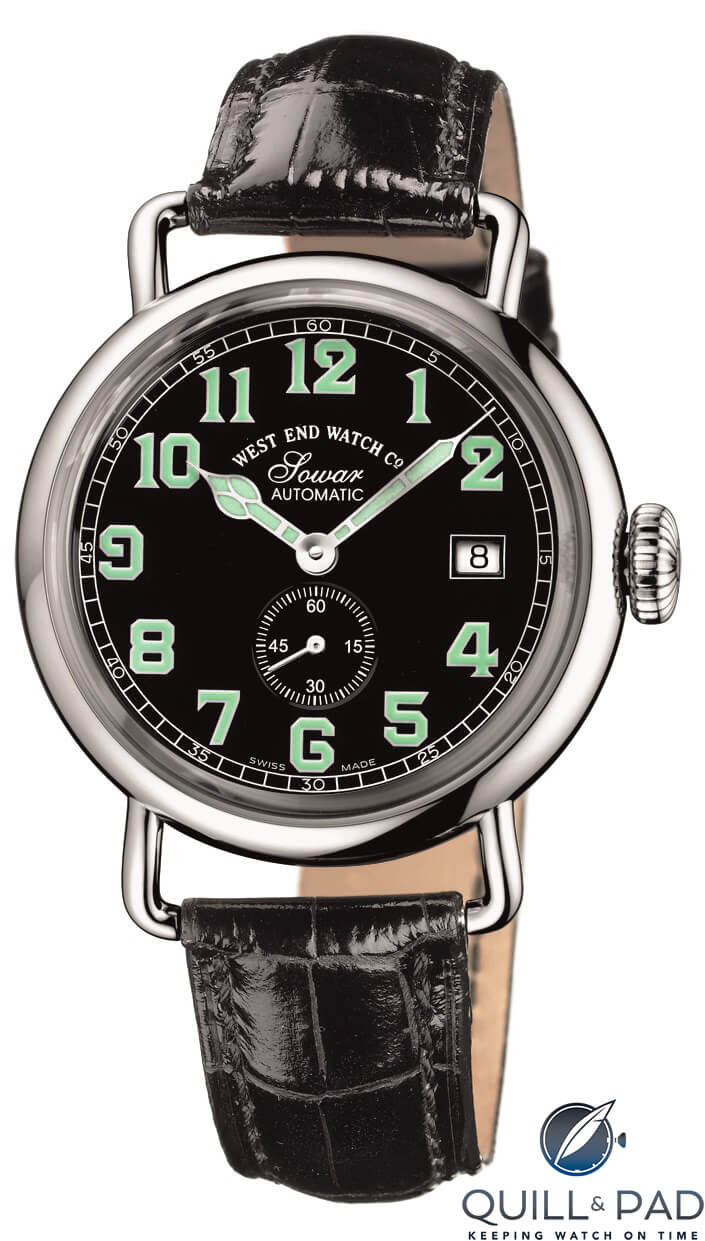
West End Watch Co Sowar Prima 1916
These include the following automatic (ETA-powered) chronographs, retailing online from £425 up to £875: the Queen Anne chronograph, an automatic ETA chronograph with military-style soldered lugs; the Sowar Prima, an automatic military style watch also available with Arabic and Tibetan numerals; and the Classics, automatic Sowar variants with a fluted bezel on a jubilee bracelet, a thoroughly respectable alternative to wearing a counterfeit Rolex if it’s the Datejust look you’re after.
Closer to home in Bordeaux
When I was first reunited with this watch, I was racking my brain trying to remember where I had quite recently come across West End Watch Co watches closer to home.
Bordeaux, where I live, is something of a desert in horological terms: there are a few authorized dealers selling the customary Rolex, Omega, and Longines lineup, but if you want an Audemars Piguet, Patek Philippe, or A. Lange & Söhne your only option is the handful of pre-owned dealers. If it’s a Greubel Forsey or an F.P. Journe you’re after you’ll have to jump on a TGV to Paris.
However, a few years ago a young Bordelais called Aurélien Cram opened Horel, a small boutique selling mainly quartz fashion watches in Bordeaux’s old town. He gradually upgraded his product range by adding affordable mechanical brands such as Baltic, Oris, Junkers, Squale, etc. and relocated last year to a larger store on Rue de la Devise to focus primarily on mechanical watches.
And that was where I saw some West End Watch Co watches last year, not realizing that that was what my first watch had been. As soon as this terrible virus business is over, I shall drop in and proudly show him my Sowar Prima.
For more information, please visit www.westendwatchco.ch.
Quick Facts West End Watch Co Sowar Prima 1916
Case: 39 mm, stainless steel, water resistant to 50 meters, sapphire crystal, transparent case back
Movement: automatic Swiss movement
Functions: hours, minutes, seconds; date
Price: £625
* This article was first published April 22, 2020 at The Grail Of Attic Finds: Reunited With The First Watch I Ever Owned, A West End Watch Co Sowar Prima
You may also enjoy:
Mythbusting: 3 Persistent Patek Philippe And Rolex Myths Debunked
Khanjar And Qaboos Rolexes: Are They The Vintage Watch Industry’s Blood Diamonds?
Watches And Guitars: Longines vs. Gibson, And John Mayer’s Take On ‘Relicing’
Gerontohorologyphobia: A Young Man’s Fear Of Being Seen Wearing An Old Man’s Watch
Leave a Reply
Want to join the discussion?Feel free to contribute!





















































Hi
I have one too belonging to my late father, Ken North. He swopped it for another watch in wartime Singapore, lost it on the beach and found at a later date. When I browsed a Rolex in 1970, it was next in the cabinet to a brand new Prima!